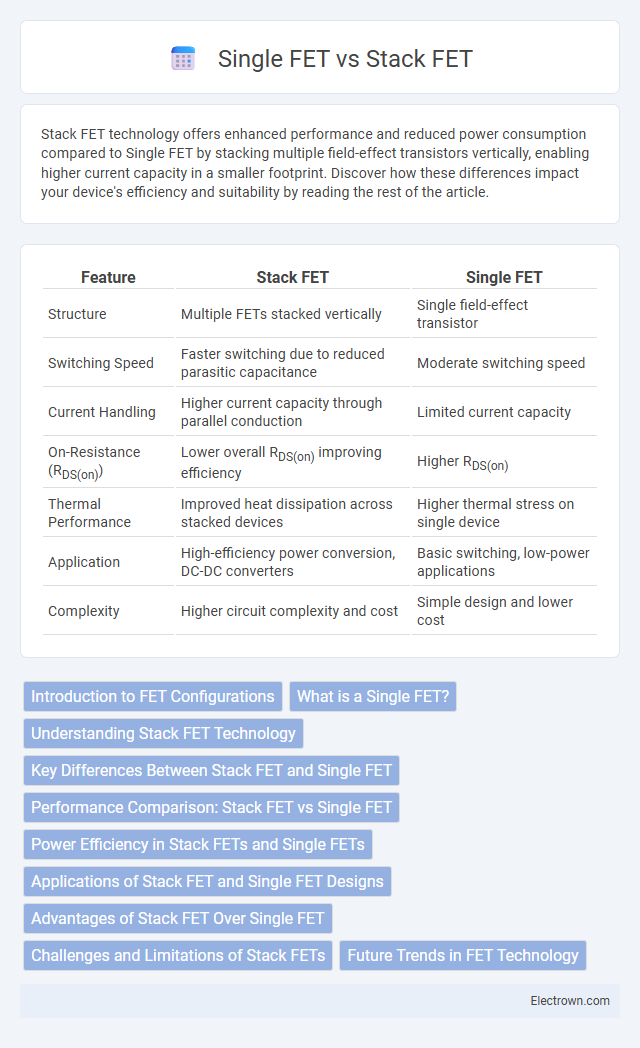Stack FET technology offers enhanced performance and reduced power consumption compared to Single FET by stacking multiple field-effect transistors vertically, enabling higher current capacity in a smaller footprint. Discover how these differences impact your device's efficiency and suitability by reading the rest of the article.
Table of Comparison
| Feature | Stack FET | Single FET |
|---|---|---|
| Structure | Multiple FETs stacked vertically | Single field-effect transistor |
| Switching Speed | Faster switching due to reduced parasitic capacitance | Moderate switching speed |
| Current Handling | Higher current capacity through parallel conduction | Limited current capacity |
| On-Resistance (RDS(on)) | Lower overall RDS(on) improving efficiency | Higher RDS(on) |
| Thermal Performance | Improved heat dissipation across stacked devices | Higher thermal stress on single device |
| Application | High-efficiency power conversion, DC-DC converters | Basic switching, low-power applications |
| Complexity | Higher circuit complexity and cost | Simple design and lower cost |
Introduction to FET Configurations
Stack FET configurations involve connecting multiple Field-Effect Transistors (FETs) in series to distribute voltage stress and improve overall device reliability, making them ideal for high-voltage applications. Single FETs, by contrast, consist of a single transistor element, offering simpler design and lower cost but limited voltage handling capacity. Understanding these differences helps you choose the appropriate FET configuration based on your circuit's voltage requirements and performance goals.
What is a Single FET?
A Single FET (Field-Effect Transistor) is a semiconductor device that uses one transistor element to control the flow of current between the source and drain terminals via an electric field applied to the gate. It offers straightforward switching operation and is commonly employed in power electronics for efficient voltage regulation and signal amplification. Compared to Stack FET configurations, a Single FET has simpler design but may have higher resistance and heat dissipation challenges under high voltage conditions.
Understanding Stack FET Technology
Stack FET technology integrates multiple field-effect transistors in a vertical stack within a single semiconductor device, enhancing switching performance and power efficiency compared to traditional Single FETs. This approach reduces on-resistance and gate charge, improving overall device speed and thermal management. The layered architecture enables advanced scaling and better control of short-channel effects, making Stack FETs ideal for high-performance power applications and next-generation integrated circuits.
Key Differences Between Stack FET and Single FET
Stack FETs consist of multiple transistor layers stacked vertically, enhancing scaling and reducing short-channel effects compared to Single FETs, which have a single transistor layer. The vertical configuration of Stack FETs improves drive current and electrostatic control, providing better performance in advanced semiconductor nodes. Single FETs typically consume less fabrication complexity but show limitations in leakage control and scaling at sub-10 nm technology nodes.
Performance Comparison: Stack FET vs Single FET
Stack FETs offer enhanced performance over Single FETs by providing higher current drive and improved channel control, resulting in reduced short-channel effects and better scalability for advanced technology nodes. The vertical stacking of transistors in Stack FETs allows for denser integration and lower parasitic resistance, which contributes to faster switching speeds and enhanced power efficiency compared to Single FET devices. Consequently, Stack FET technology is increasingly favored in high-performance computing and low-power applications due to its superior electrostatic control and minimized leakage currents.
Power Efficiency in Stack FETs and Single FETs
Stack FETs offer enhanced power efficiency by reducing leakage current and minimizing voltage stress across devices, leading to lower power loss compared to single FETs. In single FET configurations, higher leakage and increased power dissipation occur due to the entire voltage drop across a single transistor. Optimizing your circuit with Stack FETs can result in significant energy savings and improved thermal performance.
Applications of Stack FET and Single FET Designs
Stack FET designs are predominantly used in high-voltage applications such as power management circuits, motor drives, and electric vehicles due to their enhanced voltage tolerance and improved reliability under high-stress conditions. Single FET designs are favored in low-voltage, high-speed switching environments like digital logic circuits and portable electronic devices, where compact size and fast switching are critical. Understanding your specific application requirements will help determine whether the higher voltage capacity of Stack FETs or the efficiency of Single FETs best meets your design goals.
Advantages of Stack FET Over Single FET
Stack FET technology offers significant advantages over Single FET by improving switching performance and reducing on-resistance, which enhances power efficiency in electronic circuits. The stacked structure enables better control of short channel effects and provides higher voltage blocking capability, making it ideal for high-performance power management applications. Your devices benefit from reduced heat generation and increased reliability due to the enhanced current handling and improved thermal characteristics of Stack FETs.
Challenges and Limitations of Stack FETs
Stack FETs face challenges such as increased fabrication complexity and higher manufacturing costs compared to Single FETs, due to their multi-layered structure requiring precise alignment and integration. Thermal management becomes more difficult in Stack FETs because stacked layers generate more heat density, impacting device reliability and performance. Electrical parasitics and interconnect resistance also pose limitations, reducing switching speeds and overall efficiency relative to simpler Single FET designs.
Future Trends in FET Technology
Stack FET technology is emerging as a critical advancement over Single FETs by enabling higher current density and improved electrostatic control in nanoscale transistors, supporting the demands of next-generation integrated circuits. Future trends point towards greater adoption of Stack FET architectures in 3D IC designs to overcome short-channel effects and power efficiency challenges inherent in Single FETs. Your choice of transistor technology will increasingly impact performance scaling and energy efficiency as semiconductor innovation progresses towards advanced node processes like 3nm and beyond.
Stack FET vs Single FET Infographic

 electrown.com
electrown.com